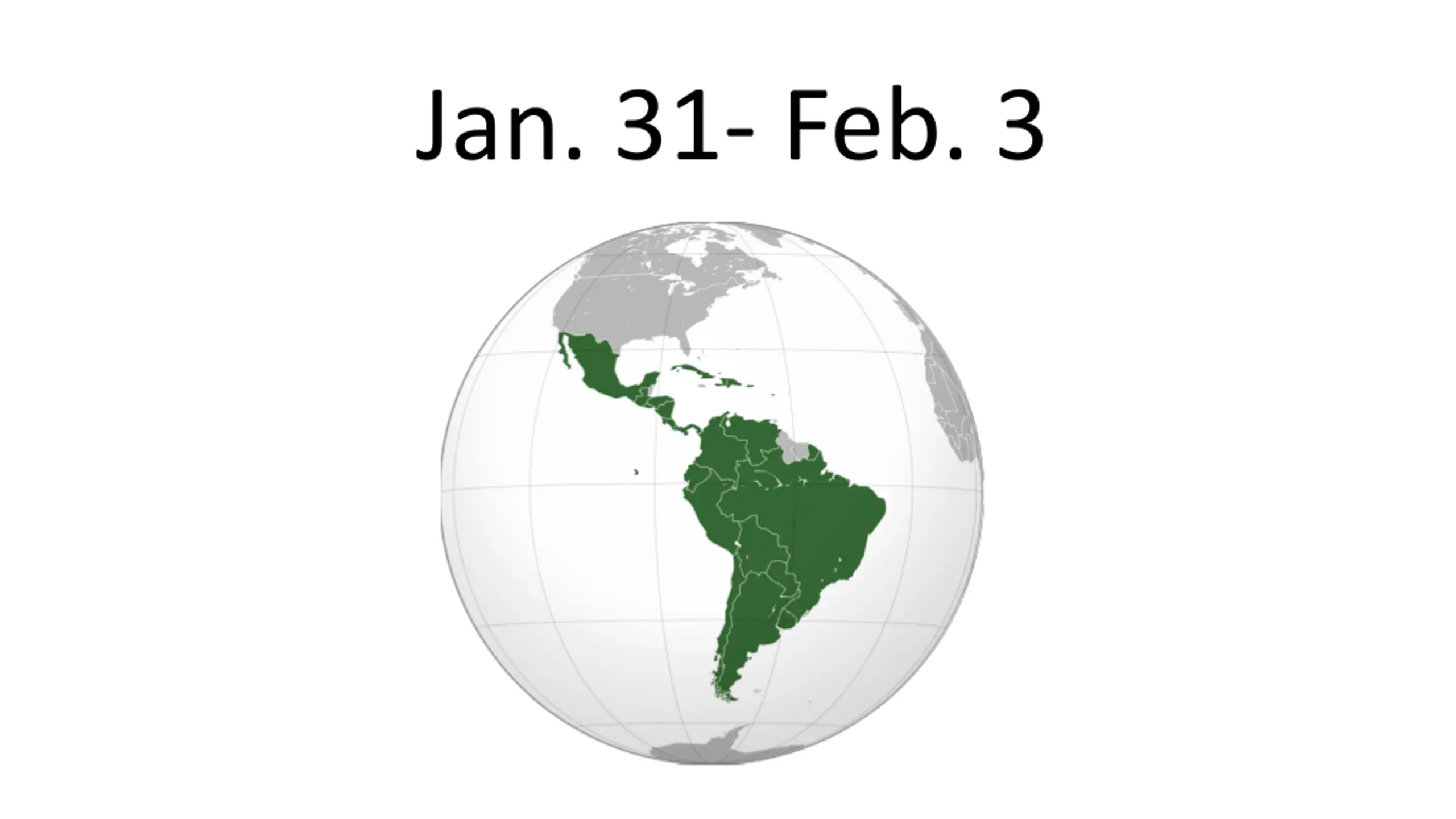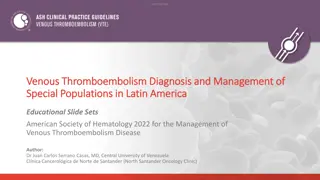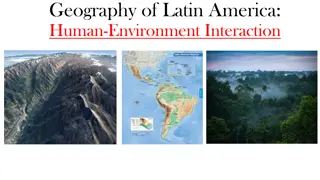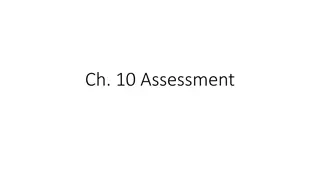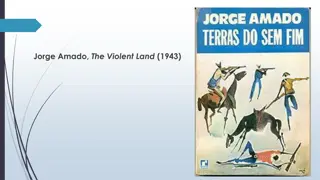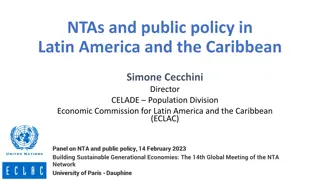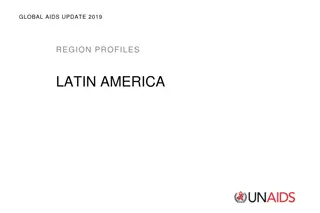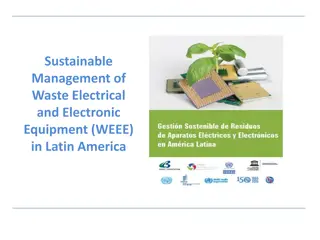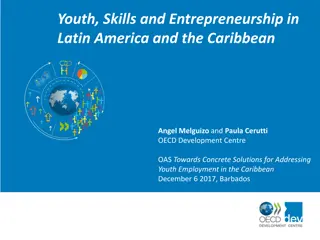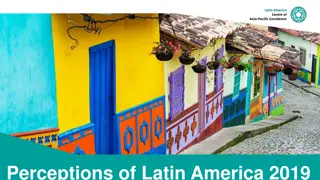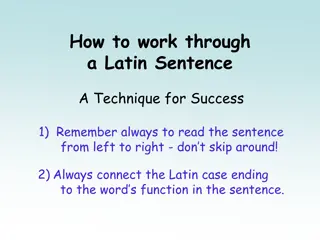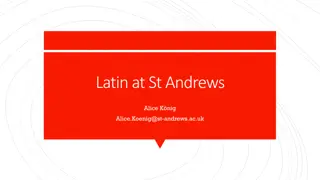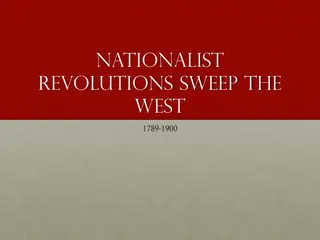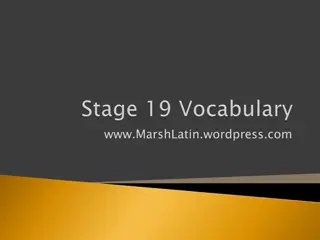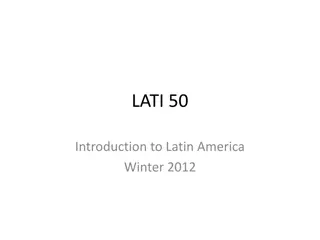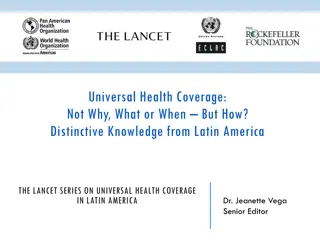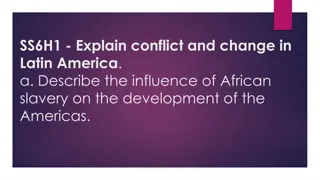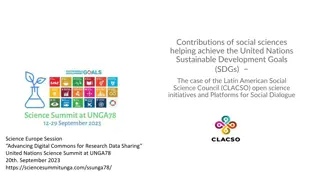Latin America Perspectives: History, Challenges, and Progress
Explore Latin America's rich history, conflicts, and environmental issues, along with the impact of Spanish and Portuguese influences. Delve into trade dynamics, poverty, and migration trends affecting the region. Learn about successful efforts to combat air pollution in Mexico City. Gain insights into social studies projects focusing on Latin America leaders. Reflect on Martin Luther King Jr.'s legacy on a designated holiday. Engage with diverse cultural and societal aspects of Latin America.
Download Presentation

Please find below an Image/Link to download the presentation.
The content on the website is provided AS IS for your information and personal use only. It may not be sold, licensed, or shared on other websites without obtaining consent from the author.If you encounter any issues during the download, it is possible that the publisher has removed the file from their server.
You are allowed to download the files provided on this website for personal or commercial use, subject to the condition that they are used lawfully. All files are the property of their respective owners.
The content on the website is provided AS IS for your information and personal use only. It may not be sold, licensed, or shared on other websites without obtaining consent from the author.
E N D
Presentation Transcript
Latin America is generally understood to consist of the entire continent of South America in addition to Mexico, Central America, and the islands of the Caribbean whose inhabitants speak a Romance language. The peoples of this large area shared the experience of conquest and colonization by theSpaniards and Portuguese from the late 15th through the 18th century as well as movements of independence from Spain and Portugal in the early 19th century. Even since independence, many of the various nations have experienced similar trends, and they have some awareness of a common heritage. www.britannica.com/place/Latin-America
Standards ( January 17-20 ) SS6H1 Explain conflict and change in Latin America. b. Describe the influence of the Spanish and the Portuguese on the language and religions of Latin America. d. Explain the impact of poverty, the war on drugs, and migration to the United States on Latin America. SS6G2 Explain the impact of environmental issues in Latin America. a. Explain the causes and effects of air pollution in Mexico City, Mexico. b. Explain the environmental issue of destruction of the rain forest in Brazil. SS6E2 Give examples of how voluntary trade benefits buyers and sellers in Latin America. a. Explain how specialization encourages trade between countries. b. Compare and contrast different types of trade barriers, such as tariffs, quotas, and embargos.
8 B Latin America 1 M D M 2 C A 3 5 e 4 H G F G 7 H K 6 H
Students will working on their Social Studies Project. This project will have two parts (Martin Luther King and Latin America Leaders). Jan.20 Feb.22
Monday, January 16 No School: Martin Luther King Holiday
Air Pollution in Mexico City Mexico City was once named as the world s most polluted city in the world, but according to IQAir, a Swiss company which keeps track of the air quality of cities around the globe, Mexico City has now dropped down to the 917th most polluted city in the world in 2021. Though its concentration of airborne particles (PM 2.5) still currently exceeds the guideline of the World Health Organization (WHO), yet the colossal improvement is undoubtable. What has been done to successfully reduce air pollution in Mexico City? And what lessons can other cities learn from it?
Tuesday, January 17 Standard: SS6G2 Explain the impact of environmental issues in Latin America. SS6H1.b Explain conflict and change in Latin America. Learning Target: Explain the impact of environmental issues (air pollution and destruction of rain forest) in Latin America; Explain conflict and change in Latin America (Describe the influence of the Spanish and the Portuguese on the language and religions of Latin America). Warm-up: video (destruction of rainforest) Work Session: Cloze Notes (Brain Wrinkles); Textbook p.346, 401; Environmental issues of Latin America (air pollution and destruction of rain forest). Spain/Portugal colonization of Latin America (language and Religion); TB p.322-323 Closing: Think-Pair-Share Reminders: Quiz on Wednesday will cover G1,G2, H1b
Click for video link Air pollution smothers industrial cities across Mexico
Destruction of the rain forest in Brazil Humans are the main cause of rainforest destruction. We are cutting down rainforests for many reasons, including: wood for both timber and making fires; agriculture for both small and large farms; land for poor farmers who don t have anywhere else to live; grazing land for cattle; pulp for making paper; road construction; and extraction of minerals and energy. An estimated 18 million acres (7.3 million hectares) of forest roughly the size of Panama
Wednesday, January 18 Standard: SS6G2 Explain the impact of environmental issues in Latin America. SS6H1.b Explain conflict and change in Latin America. Learning Target: Explain the impact of environmental issues (air pollution and destruction of rain forest) in Latin America; Explain conflict and change in Latin America (Describe the influence of the Spanish and the Portuguese on the language and religions of Latin America). Warm-up: video (religions of Latin America) Work Session: Cloze Notes (Brain Wrinkles); Textbook p.346, 401; Environmental issues of Latin America (air pollution and destruction of rain forest). Spain/Portugal colonization of Latin America (language and Religion); TB p.322-323 Closing: TOD Reminders: Quiz will cover G1,G2, H1b
Languages of Latin America: 1) Spanish 2) Portuguese 3) English 4) German 5) Italian
The majority of Latin Americans are Christians (90%), mostly Roman Catholics.
Thursday, January 19 Standard: SS6H1.d Explain conflict and change in Latin America. d. Explain the impact of poverty, the war on drugs, and migration to the United States on Latin America. SS6E2 Give examples of how voluntary trade benefits buyers and sellers in Latin America. a. Explain how specialization encourages trade between countries. b. Compare and contrast different types of trade barriers, such as tariffs, quotas, and embargos. Learning Target: Explain the impact of poverty, the war on drugs, and migration to the United States on Latin America Warm-up: Video (poverty in Latin America, the war on drugs, migration to the US) Work Session: Cloze Notes (Brain Wrinkles); Textbook p. 329-333; poverty; war on drugs and migration to US. Economics: specialization encourages trade, trade barriers. Closing: Student Summarize Reminders:
The Social Panorama 2022 report projects that 201 million people (32.1% of the region s total population) live in situations of poverty, with 82 million (13.1%) of them in extreme poverty. The regional organization calls for urgently addressing the silent crisis in education to avert the risk of a lost generation.
Friday, January 20 Standard: SS6H1.d Explain conflict and change in Latin America. d. Explain the impact of poverty, the war on drugs, and migration to the United States on Latin America. SS6E2 Give examples of how voluntary trade benefits buyers and sellers in Latin America. a. Explain how specialization encourages trade between countries. b. Compare and contrast different types of trade barriers, such as tariffs, quotas, and embargos. Learning Target: Explain the impact of poverty, the war on drugs, and migration to the United States on Latin America Warm-up: Practice Latin America Map with Partner Work Session: Cloze Notes (Brain Wrinkles); Textbook p. 329-333; poverty; war on drugs and migration to US. Economics: specialization encourages trade, trade barriers; Stations Closing: Think-Pair- Share Reminders:
Standards SS6G1 Locate selected features of Latin America. a. Locate on a world and regional political-physical map: Amazon River, Amazon Rainforest, Caribbean Sea, Gulf of Mexico, Atlantic Ocean, Pacific Ocean, Panama Canal, Andes Mountains, Sierra Madre Mountains, and Atacama Desert. b. Locate on a world and regional political-physical map the countries of Brazil, Chile, Colombia, Cuba, Mexico, and Panama. SS6G2 Explain the impact of environmental issues in Latin America. a. Explain the causes and effects of air pollution in Mexico City, Mexico. b. Explain the environmental issue of destruction of the rain forest in Brazil. SS6H1 Explain conflict and change in Latin America. b. Describe the influence of the Spanish and the Portuguese on the language and religions of Latin America. d. Explain the impact of poverty, the war on drugs, and migration to the United States on Latin America.
Questions: 1. What type of environmental issue does Mexico City face? 2. What is the biggest cause for this pollution? 3. What physical features of Mexico City add to the problem? 4. What measures are the Government putting into place to help solve this problem? 5. Why is the rainforest important? 6. List some reasons why the rainforest is being destroyed? 7. How doe this impact the environment and the world?
